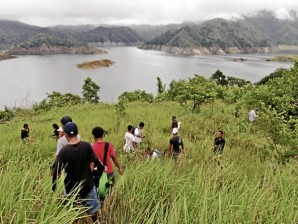
VOLUNTEERS prepare for a Philippine Eagle habitat by planting trees at the San Roque dam watershed at Sitio Sapuac in San Manuel, Pangasinan. The dam’s reservoir is at the background. JOJO RINOZA/ CONTRIBUTOR
The rare and endangered Philippine Eagle may soon be flying over the San Roque Dam watershed in San Manuel, Pangasinan, once San Roque Power Corp. (SRPC) succeeds in creating a sanctuary for the national bird.
Tom Valdez, SRPC vice president for corporate social responsibility, shares this optimism after a team of volunteers from the Philippine Eagle Foundation (PEF) saw a pair and an offspring of the Philippine Eagle (Pithecophaga jefferyi) thriving in the forests of Calanasan town in Apayao recently.
“There is an ongoing research on the eagle’s habitat. If the researchers find that the eagles habitat in Apayao will match what we have here, then we can transfer a pair of eagles in the [San Roque] watershed,” Valdez says.
The Philippine Eagle is in the brink of extinction because of continuous hunting and deforestation.
Protected area
“Fortunately, the newly discovered eagle pair and its forest habitat at Calanasan are in an indigenous protected area, which is spared from logging, hunting and other forms of human exploitation,” Valdez says.
In creating the eagle’s habitat, Valdez says SRPC launched last year a five-year massive tree planting activity in the 9,000-hectare watershed.
“We called it ‘Grow a Tree’ and this is also part of our commitment to the National Greening Program of the government. San Roque will plant trees in 500 ha in the next five years,” Valdez says.
In July last year, some 1,200 people from 18 groups planted 22,000 seedlings in a 50-ha area of the watershed during the project launch.
Tree planting
This year, Valdez says, 18 groups, including the Philippine National Police, Armed Forces of the Philippines and the local chapter of the Kapisanan ng mga Brodkaster ng Pilipinas (KBP) have planted trees in different areas of the watershed since June 15.
“Our target this year to plant 50,000 seedlings in 100 ha. But we prepared 67,000 seedlings for the year. We are now on our second year, so we will continuously do this in three more years,” Valdez says.
He says many more groups have been volunteering to join the tree planting activity.
The San Roque Dam, which was blamed for the widespread flooding in eastern and central Pangasinan as Typhoon “Pepeng” struck in 2009, was launched as Pangasinan’s new face of ecotourism in March.
Bernie Errasquin, Radyo ng Bayan station manager and KBP-Pangasinan president, says that on their way to the tree-planting site, they descended to the dam’s reservoir to ride on a thatch-roofed, wood-decked, nipa hut-inspired boat and cruised for 45 minutes on the reservoir.
Other wildlife
While on their way to Sitio Sapuac, they were treated to the scenic views of the Cordillera and Caraballo mountains and the reservoir’s serene water.
“There were also wild ducks swimming and flying along the way,” Errasquin says.
The Wild Bird Club of the Philippines found during a visit in 2008 that more than 2,000 Philippine ducks (Anas luzonica) and 40 bird species, nine of them endemic, live in the reservoir area.
Valdez says that based on the PEF research in Apayao, the Cordillera mountains can be an eagle habitat.
“But based on the results of this survey, the extent of good forest habitats which the expedition team saw in Apayao and nearby provinces, the Cordillera seems to be an eagle stronghold too,” Valdez says.
The eagles were earlier thought to be thriving only in the forests of Mindanao.
“When we finally have them here, the eagles will become the rallying point in protecting our watershed,” Valdez says.